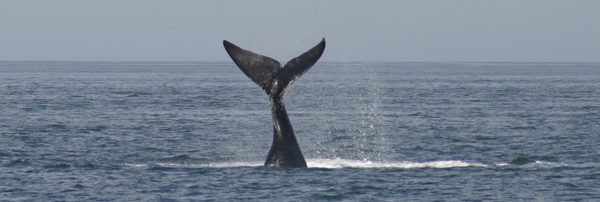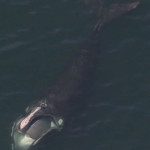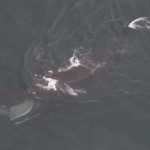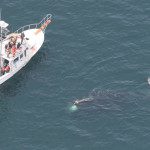April 2008

23 April. Starting in the south of the bay today, the aerial survey team was keen to see whether right whales were still using this area, which had not been covered in the previous survey. Fin whales were still plentiful, and right whales were sighted along the southerly tracklines, though in less dense groups than have been recently observed. Photographing was a difficult task today; rough seas obscured the whales’ heads when they surfaced, and gusts of wind made the pilots’ job of circling even more demanding. In addition, the whales were less active on the surface than they have been in recent weeks, and many individuals appeared to be making long dives, as they had been doing earlier in the season. Unfortunately, the wind picked up as the day progressed and eventually the survey was terminated due to worsening sea state. We sighted 31 right whales, including one mother-calf pair.
23 April. The right whale habitat studies team was anxious to find out how the distribution of zooplankton and right whales in Cape Cod Bay had changed since the previous cruise, as in years past the whales have begun to exit the Bay around this time. After a bit of searching through slowly clearing fog, we found a number of right whales spread around the central and north-central parts of the Bay. The zooplankton resource, where it had been so concentrated just days before, was no longer there; it had probably been either grazed down, advected away, or both. Even samples taken in the paths of skim-feeding right whales appeared less dense than those collected on the previous couple of cruises. In addition to the 18 to 23 scattered right whales, the habitat team sighted three humpback whales, seven fin whales, and a very large pod of Atlantic white-sided dolphins. We are interested to see whether there will be a rebound of the zooplankton resource in a different part of the bay, and whether the right whales will continue to move north, away from Cape Cod Bay.
21 April. Despite low clouds and poor visibility, the aerial survey team made their way up to the northern part of the bay today to start the survey. A large number of fin whales were sighted, as well as several humpback whales. The team recorded three right whale mother-calf pairs, including one energetic calf which entertained our pilots by breaching several times in a row! The team had some great views of the R/V Shearwater, surrounded by a particularly dense aggregation of skim feeding and sub-surface feeding right whales. Many right whales were also sideways feeding, allowing for great views of the baleen plates in their mouths as they filtered their plankton prey from the water. Interestingly, a flyover at Jeremy Point revealed that no seals were hauled out there despite it being near to low tide. This suggests that the seals may now be moving north for the summer months. A total of 53 right whales were recorded, spread throughout the bay but with a concentration of animals in the northeastern part. The survey finished a little early, due to encroaching cloud at Chatham airport. Nonetheless, the team completed 12 of the 15 tracklines in the bay, which is the most we have managed in the past few weeks, with so many whales keeping us busy!
19 April. We lifted off from Chatham and began in the south end of Cape Cod Bay. The weather was gorgeous with a calm sea state and we began to quickly photograph all the right whales we encountered on our tracklines. Over the course of the next nine hours, we covered ten tracklines and photographed 62 right whales, including three mother/calf pairs and the injured EGNO 3530. We are all anxious to spend some time back in the office looking at all of our data, so that we can get a minimum estimate on the number of individual right whales that have been utilizing Cape Cod Bay these few weeks!
16 April. We departed from Chatham bright and early and flew up the backside of Cape Cod Bay. As we transited north about three miles from the shoreline, the ocean was pretty quiet except for the occasional minke whale sighting. As we approached Race Point, we began to see much more activity… right whales subsurface feeding, humpback whales bubble feeding, huge fin whales gliding by, pods of dolphins, and diving gannets! As we began to circle the aircraft to obtain images for photo identification, we soon realized that we had a right whale in the area that was entangled in fishing rope. This whale was quickly identified as EGNO 1980, the entangled whale we had seen in Cape Cod on March 14th of this year. North Atlantic right whales are critically endangered, with less than 400 individuals remaining in the entire species. The leading causes of mortality are both anthropogenic (caused by human activities) – ship strike and entanglement in fishing gear. Since the survival of each individual right whale is so critical for preventing the extinction of the species, every effort is made to disentangle right whales seen carrying gear. We contacted the PCCS disentanglement team who quickly arrived on the scene aboard the R/V Ibis, and stood by to assist them from the air. Unfortunately, the whale simply did not tolerate the kind of close approaches necessary to cut the rope, and we reluctant left him at the end of the day without having made much progress. We did obtain thorough photo documentation, both from the aircraft and the vessel, which will greatly assist in assessing the condition of the whale and formulating a plan for disentanglement.
15 April. Having covered the northern part of Cape Cod Bay during the previous survey, we were eager to see whether or not there were still whales in the southern portion of the bay. It didn’t take long to find out. As soon as we flew over Barnstable Harbor we could see the distinct, V-shaped spouts of dozens of North Atlantic right whales spread out over several miles. As we circled over each animal, we found that most of them were feeding just below the surface. The filaments of their baleen are about as fine as human hair, and are well suited for trapping flea-sized planktonic organisms. Frequently, plankton will congregate along a front, where two water bodies or currents converge. Right whales will sometimes line-up along these fronts, maximizing their food intake. During this survey, we saw over twenty whales lining up along one of these fronts with their mouths wide-open! The large number of whales prevented us from covering our northernmost track lines, but in the southern half of the bay we counted over 70 right whales!
14 April. Due to the high winds, we didn’t lift off from the Chatham airport until almost noon. We flew up the backside of Cape Cod bay and found quite a few right whales off of Race Point despite the choppy seas. Documenting and photographing the 58 right whales that we spotted took so much time that we didn’t even make it through half of our survey area! Highlights of the afternoon included a sighting of Slalom (also known as EGNO 1245) and her calf. We also saw humpbacks, fin whales, white-sided dolphins, and hundreds of gannets!
11 April. The cruise on April 11th we found that approximately 20 right whales were still feeding around the mouth of Provincetown Harbor, and close to the western shore of Wellfleet. In order to look at the horizontal extent of the resource that was holding the whales there, we collected shallow zooplankton samples in a grid-pattern across the area. We were able to see the planar distribution of layer, and noticed that the edge was sometimes delineated by a slick. We also took two vertical series of samples to see how deep the layer went, and found that it was a surface layer (3-4 meters deep). We are interested to see when the whales will begin to depart from the Bay, and what the zooplankton resource looks like at that point. We are also beginning to see increasing numbers of fin whales and a large pod of Atlantic white-sided dolphins in the Bay.
11 April. We took advantage of the fair weather with our fourth survey in a row! Once again we found numerous right whales scattered throughout the middle of the bay, feeding both at the surface (skim feeding) and just below it (subsurface feeding). We even photographed one right whale feeding sideways! We also got a photo of EGNO 2790’s calf up at the surface between two feeding adults, really shows how tiny the calf is! We saw quite few seals- about forty off of Plymouth and another hundred or so off of Jeremy Point near Wellfleet. Photos of the seals at Jeremy Point revealed both grey and harbor seals, although harbor seals were much more numerous. The survey ended prematurely due to incoming rain and loss of visibility, so we were only able to survey the bottom portion of the bay. Even this short survey was enough to demonstrate that the right whales are still spread throughout the bay and taking full advantage of the rich food resources present!
10 April. After seeing so many whales in Cape Cod Bay yesterday, we were anxious to go have a look up further north to see what we missed. Unfortunately, the fog dampened our enthusiasm for an early morning takeoff, and we spent much of the day pacing around the airport anxiously waiting for the sky to clear. Finally we got off the ground at 2 pm and headed up the backside to begin our survey in the northern part of Cape Cod Bay. We were rewarded with an amazing abundance of wildlife off of Race Point and Wood End… we documented 56 right whales in addition to humpback whales, fin whales, and dolphins! We also had our first sighting of a right whale mother and calf in Cape Cod Bay this season. The mother, known as EGNO 2790, was first seen with her newborn calf by the FWRI aerial survey team off the coast of Florida on February 3rd. Just as the daylight was beginning to fade and we were about ready to head back in, we came across EGNO 3530 (severely injured) and EGNO 2645 (entangled) very close to Provincetown harbor. We contacted the PCCS disentanglement team who raced to the scene and we were able to stand by and assist just long enough to help them locate the whales before we had to return to the airport.
09 and 10 April. The PCCS right whale habitat studies’ cruises on April 9th and 10th were both half-day cruises, as we had some guests from the media with us. The ninth was a calm overcast day with excellent visibility. With help from the aerial survey team, we made our way to an aggregation of over 50 right whales; they were feeding on a rich Calanus finmarchicus layer at and near the surface in the southwestern portion of the Bay. In addition to this large group, we sighted approximately 20 more individuals elsewhere, indicating that there were upwards of 70 North Atlantic right whales in the Bay that day! Conditions on the following day, the 10th, were less conducive to sighting whales, as the morning brought with it moderate seas, but a thick fog enabling visibility of no more than 200 meters. Our observations revealed an apparent movement of right whales away from the southwestern portion of the Bay, and towards the northeastern portion. A number of whales were sighted just at the mouth of Provincetown Harbor, where numerous pieces of gear appear to have been stored for the winter, and where there is increased boat traffic. As a result of our observations, an alert was issued in attempt to avoid boat collisions with whales. Our vertical sampling and plankton tows continue to show a rich zooplankton resource that appears to be keeping the whales in Cape Cod Bay for the time being.
09 April. There were reports of fog in the northern part of the bay, so we began surveying to the south. Very soon we came across a single whale, traveling due south. We then encountered a surface active group (SAG), comprising three whales actively rolling and splashing at the surface. As we continued on our survey we encountered many more individuals, swimming directionally just below the surface with their mouths open, subsurface feeding. A group of five whales began feeding in an echelon formation, coordinating their movements with one another. We made our way slowly through the southern part of the bay, stopping to photograph each right whale that we encountered. We sighted both EGNO 2645, an entangled whale which was documented on our first survey of the year and several times since, and EGNO 3530, the severely injured whale first documented early this year in Florida. We contacted the disentanglement team and photographed both whales thoroughly to allow for an updated health assessment. The disentanglement team arrived on the scene and we were able to stand by and assist as they attempted to get a biopsy sample from the entangled EGNO 2645. Unfortunately, its sub-surface feeding behavior and rare appearances above water made it difficult for the team to find the right moment to approach the whale. Throughout the course of the day, we encountered and photographed at least 55 whales, and only made it halfway up the bay! Reports from the Provincetown Center for Coastal Studies research vessels indicated that there were also right whales in the vicinity of Provincetown, so there were even more whales present than indicated by our aerial survey data! The total estimated number of North Atlantic right whales is less than 400 individuals, so we have a really have a significant portion of the entire species in Cape Cod Bay right now!
08 April. After a long spell of unfavorable conditions, we finally had some good weather and it was time to find out whether any more whales had made their way into Cape Cod Bay. The sea was still a little choppy, but we were hopeful that conditions would improve. Starting in the south of the bay, we swiftly began encountering whales skim feeding and sub-surface feeding. Before long, we had an estimated total of 35 right whales and that was not even a complete survey of bay! The whales were concentrated in the central and western parts of the bay.

Our Work
Humpback Whale Research
Right Whale Research
Marine Animal Entanglement Response
Marine Geology Department
Water Quality Monitoring Program
Marine Fisheries Research
Seal Research
Shark Research
Marine Education
Interdisciplinary
Marine Debris and Plastics Program
Marine Policy Initiative
Cape Cod Climate Change Collaborative
Publications






